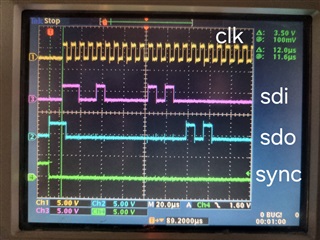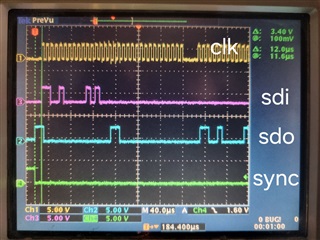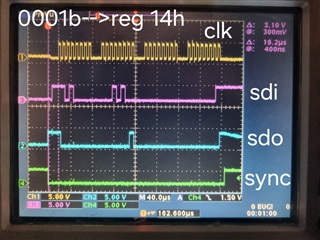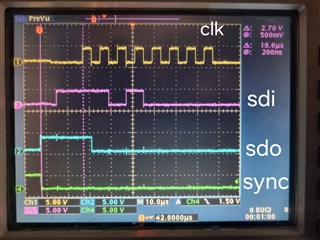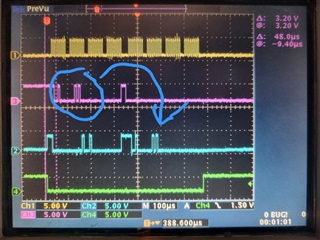Tool/software:
void ADS8691_Init(uint8_t adc_num)
{
// 1. Plage d’entrée : Bipolaire ±10.24V 0x0001 dans le registre 0x14
ADS8691_WriteRegister(adc_num, REG_INPUT_RANGE, RANGE_BIPOLAR_10V24);
// 2. Référence interne activée en permanence 0x0003 dans le registre 0x3C
ADS8691_WriteRegister(adc_num, REG_REF_CTRL, REF_INTERNAL_ALWAYS_ON);
// 3. Configuration ligne SDI : mode normal 0x000 dans le registre 0x3E
ADS8691_WriteRegister(adc_num, REG_SDI_CTRL, SDI_DEFAULT);
// 4. Configuration ligne SDO : toujours activée 0x000 dans le registre 0x3F
ADS8691_WriteRegister(adc_num, REG_SDO_CTRL, SDO_DEFAULT);
}
void ADS8691_WriteRegister(uint8_t adc_num, uint8_t reg, uint16_t value)
{
uint32_t cmd = CMD_WRITE_REGISTER | ((reg & 0x3F) << 16) | (value & 0xFFFF);
uint8_t tx[4] = {
(cmd >> 24) & 0xFF,
(cmd >> 16) & 0xFF,
(cmd >> 8) & 0xFF,
(cmd >> 0) & 0xFF
};
GPIO_TypeDef* sync_port = (adc_num == 1) ? ADC1_SYNC_GPIO_Port : ADC2_SYNC_GPIO_Port;
uint16_t sync_pin = (adc_num == 1) ? ADC1_SYNC_Pin : ADC2_SYNC_Pin;
sync_port->BSRR = (uint32_t)sync_pin << 16; // SYNC LOW
HAL_SPI_Transmit(&hspi2, tx, 4, HAL_MAX_DELAY);
sync_port->BSRR = sync_pin; // SYNC HIGH
HAL_Delay(1);
}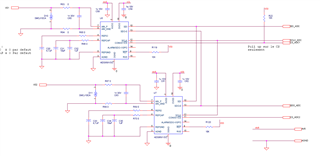
I tried to oscillate the commands from clk, sdi, sdo, and sync, which seem correct to me, but where I should have the register data on the last two bytes of the 32-bit frame, I get nothing.
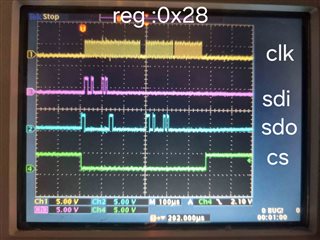
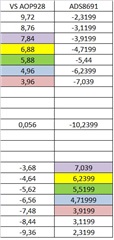
I can see that the ADS8691 is reacting, since it responds in SDO with the same data relating to the register queried in SDI?...
float ADS8691_ReadVoltageFast(uint8_t adc_num, float offset_correction)
{
GPIO_TypeDef* sync_port;
uint16_t sync_pin;
if (adc_num == 1) {
sync_port = ADC1_SYNC_GPIO_Port;
sync_pin = ADC1_SYNC_Pin;
} else {
sync_port = ADC2_SYNC_GPIO_Port;
sync_pin = ADC2_SYNC_Pin;
}
uint8_t tx_buf[4] = {0x00, 0x00, 0x00, 0x00}; // NOP
uint8_t rx_buf[4] = {0};
// SYNC LOW
sync_port->BSRR = (uint32_t)sync_pin << 16;
HAL_SPI_TransmitReceive(&hspi2, tx_buf, rx_buf, 4, HAL_MAX_DELAY);
// SYNC HIGH
sync_port->BSRR = sync_pin;
uint32_t raw = ((uint32_t)rx_buf[0] << 24) |
((uint32_t)rx_buf[1] << 16) |
((uint32_t)rx_buf[2] << 8) |
((uint32_t)rx_buf[3]);
// Sign-extended 18-bit value extraction
int32_t code = ((int32_t)(raw << 2)) >> 14;
float voltage = code * 0.000078125f;
return voltage + offset_correction;
}


